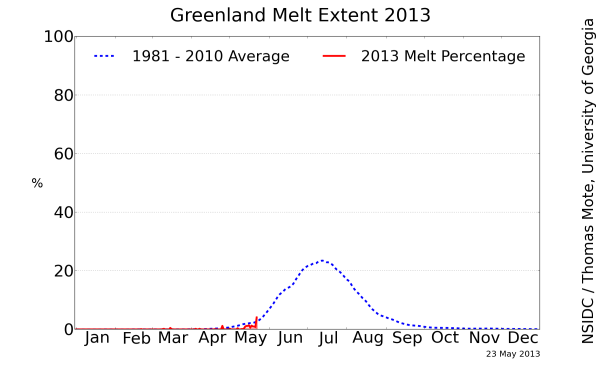(Image source: NSIDC)
Greenland ice sheet melt spiked today, moving into above average territory with nearly five percent of the ice sheet showing surface melt. Influx of warmer air from the south combined with ongoing heat absorption by the ice sheet to push melt levels higher over a broad area of southern Greenland. Temperatures rose above freezing for most of southern Greenland while much colder air remained concentrated to the north.
(Image source: NSIDC)
Over much of the Arctic, warmer air is invading northward. Above freezing temperatures are now common around Hudson Bay, in Northwestern Canada, in Northern Alaska, over sections of the Bering, Beaufort and Kara Seas, and are nearing the coast in East Siberia. Higher temperatures pushing northward have not only set off Greenland melt, but overall Northern Hemisphere snow cover continues to push into lower than average territory.
This rapid melt is especially worthy of note considering the massive amount of snow dropped by major storms this winter over much of the Northern Hemisphere. Should pace of snow melt continue, we may be on track for another record year.
Last year, both Greenland surface ice melt and Northern Hemisphere snow melt plunged into record low territory. Greenland melt was particularly exceptional with nearly 100% of the surface area of Greenland showing melt on certain days during July. The last time a similar level of melt occurred on Greenland was more than 100 years ago. A repeat of this kind of melt at any time within the next decade would be unprecedented. However, given current levels of Arctic warming, such melt is certainly possible.
Loss of tundra in certain regions appears to be one of the key drivers of enhanced snow melt during summer time. Arctic warming over the past few decades has continued to push the tundra line northward. As a result, snow is less resilient in northern regions come summer.
Links:










1 Comment